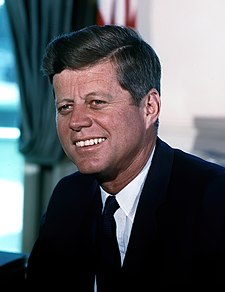2.10: use the completed fact file in the example 4 to write a short biography of John F. Kennedy for an international school magazine.
John Fitzgerald Kennedy ( Brookline , Massachusetts, May 29, 1917 - Dallas, Texas, November 22, 1963 ) was the thirty-fifth President of the United States. He was known as John F. Kennedy , Jack Kennedy by his friends and popularly as JFK.
Elected in 1960 , Kennedy became the second youngest president of his country , after Theodore Roosevelt. He served as President since January 20, 1961 until his assassination on November 22, 1963 . During his government the invasion of the Bay of Pigs , the missile crisis in Cuba , the construction of the Berlin Wall , the home took place the space race and the consolidation of the Civil Rights Movement in the United States as well as the early events of the Vietnam War .
During World War II , highlighted by his leadership as commander of the torpedo boat PT- 109 in the South Pacific area . Performing recognition , the PT- 109 was hit by a Japanese destroyer , which left the boat in two and caused an explosion . The crew in charge managed to swim to an island and survive to be rescued. This feat gave her popularity and began his political career . Kennedy represented the state of Massachusetts as a member of the House of Representatives from 1947 to 1953 and then as a senator from 1953 until his inauguration in 1961. At 43 years old, was the presidential candidate of the Democratic Party in the 1960 elections , defeating Richard Nixon in one of the tightest votes of presidential history. Kennedy was the last person to be elected to exercise the office of senator. He has also been the only Catholic to be elected president of EE . UU . to date and the only one born during the First World War and the first born in the twentieth century.
President Kennedy was assassinated on November 22, 1963 in Dallas, Texas, United States 2 . Lee Harvey Oswald was arrested and charged with the murder, but was murdered two days later by Jack Ruby , so it could not stand trial . The Warren Commission concluded that Oswald had acted alone in the assassination . However, the House Select Committee on Assassinations in 1979 estimated that there was a conspiracy surrounding the murder . This topic has been much debated and there are multiple theories about the assassination . The crime was an unforgettable moment in U.S. history because of its traumatic impact on the memory of the nation .
Many have viewed Kennedy as an icon of American hopes and aspirations ; in some surveys in the country continues to be counted as one of the best presidents of the United States.

 CAR
CAR  BUS
BUS  TAXI
TAXI TRAIN
TRAIN  BIKE
BIKE  VAN
VAN TRAM
TRAM  UNDERGROUND
UNDERGROUND  PLANE
PLANE HELICOPTER
HELICOPTER








